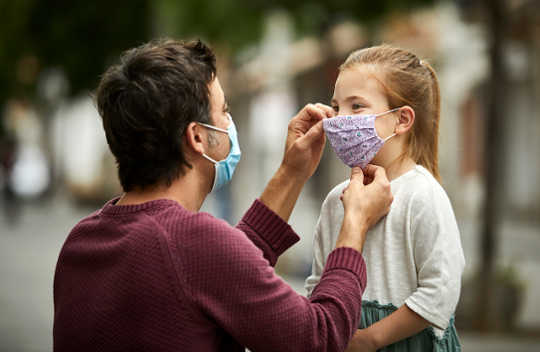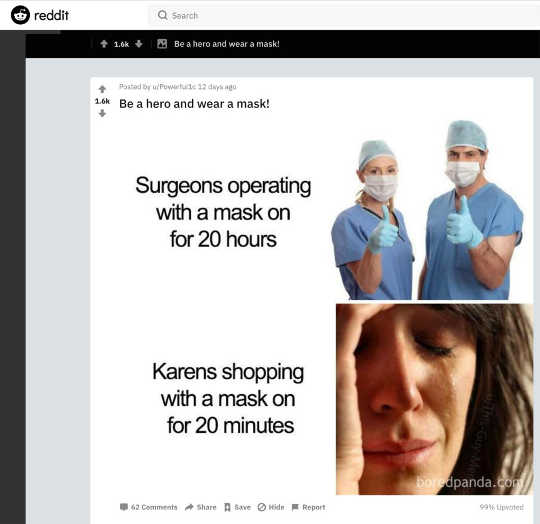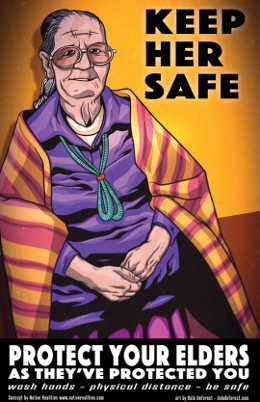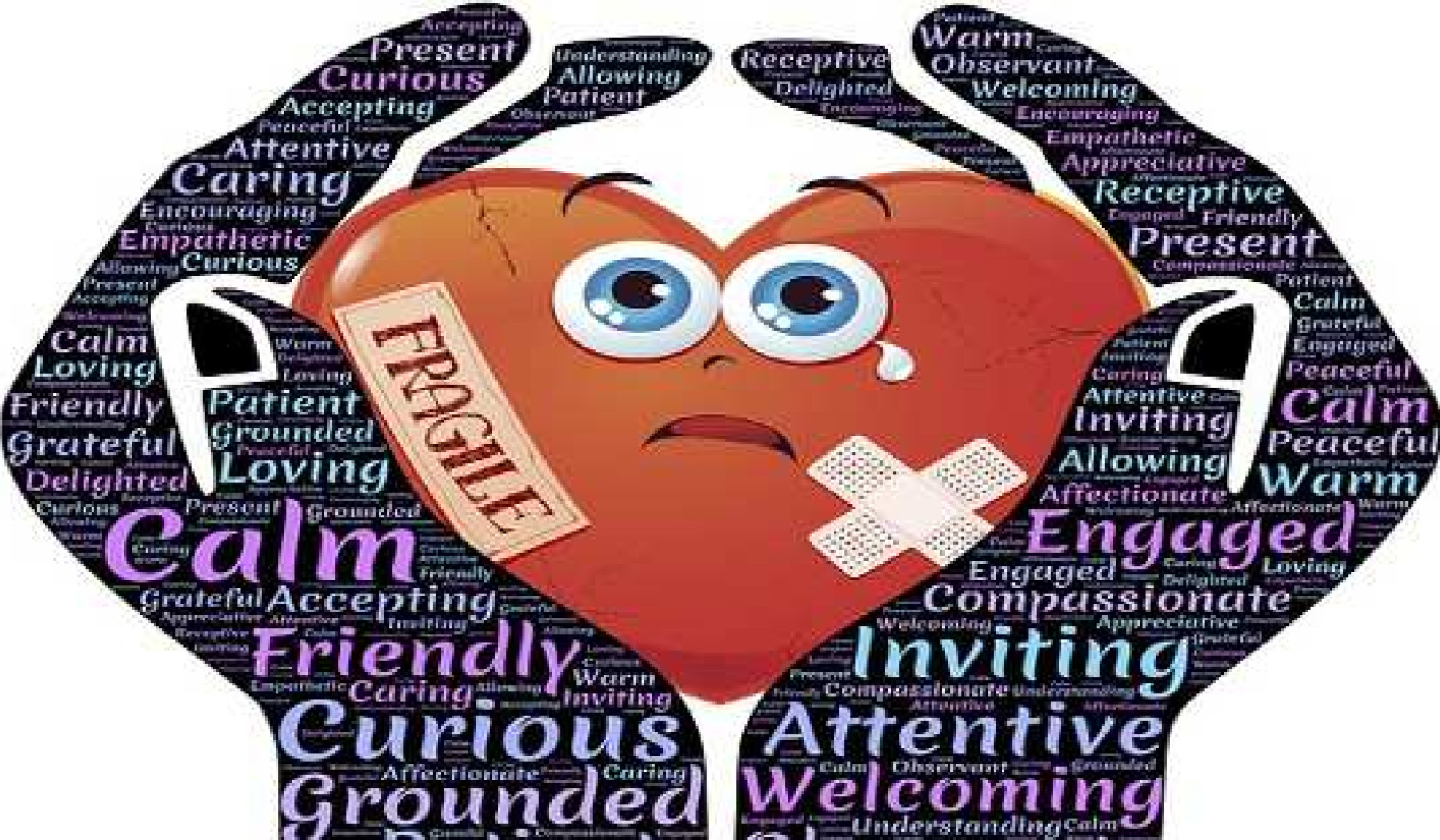
Photo by Morsa Images/Getty Images
I’m not a public health educator, but I play one on social media. Maybe you do too. As the COVID-19 pandemic rages on, many people have found themselves serving as armchair epidemiologists and pundits, tracking the virus, projecting the future, and browbeating people who refuse to stay home or wear masks.
The vast majority of social media memes I’ve seen are terrific at validating the behavior of people who are already diligently masking and social distancing. But they are terrible at persuading skeptics to abide by public health precautions. Neuroscientist Emiliana Simon-Thomas says that people often lash out vitriolically when they perceive others as being insufficiently self-sacrificing, but she says that doing so triggers resistance. “People don’t appreciate being told what to do by someone they don’t know,” explains Simon-Thomas, science director of the University of California, Berkeley’s Greater Good Science Center.
Being on the receiving end of unsolicited feedback can make people feel more entrenched and righteous about their behavior, especially if the feedback has a shaming quality. “[T]rying to shame people into healthy behavior generally doesn’t work,” Harvard epidemiologist Julia Marcus says, “and actually can make things worse.”
Drawing on the advice of public health experts and my own expertise in communication across lines of political difference, I offer the following advice for encouraging COVID-19 rebels to mask up:
What not to do
- Don’t label or insult. If you call someone a “Covidiot” or a “selfish racist,” what are the odds they will engage in a period of deep reflection before giving you a Facebook hug, thanking you for enlightening them, and asking where they can purchase a sweatshop-free mask?
Name-calling is highly antagonizing. It destroys trust, engenders hostility, and can make a person even less apt to wear a mask just to spite you. They may very well have racist beliefs that lead them to devalue the lives of Black and brown virus victims, but the minute you call them a racist, they will stop listening, and you will have achieved nothing.

People who don’t wear a masks are “dummies” to be ridiculed. A screenshot of Chris Cuomo’s Instagram post.
- Don’t be self-righteous, condescending, or judgmental. Like insults, casting blame or making moral judgments puts people on the defensive. It doesn’t matter that heeding public health directives is objectively better than not doing so, just like it doesn’t matter that bringing cloth bags to the grocery store is objectively better for the environment than not. If you are sanctimonious about your behavioral choices, people who don’t yet subscribe to them will be annoyed and disgusted, and they will not contemplate changing their ways.
In the early days of the pandemic, my Facebook feed was filled with stern reprimands of those who were considering wearing a mask to protect themselves. Mask-wearers, they said, were selfish, bad people who didn’t care that health care workers were facing an N-95 mask shortage. Even a bandanna sent the wrong message. Then, the evidence started stacking up: Masks reduced virus transmission by 75%, and countries that required masks were flattening the curve faster than those that didn’t. Now, social media is saturated with denunciations of Americans who refuse to wear a mask. Acknowledgement that such contradictions are confusing and frustrating can go a long way.
- Don’t vilify or polarize. Though the virus is now hitting red states and some rural areas hard, this was not the case in the early days of the pandemic. It’s understandable that people whose suffering stems more from the economic and social impacts of the shutdown than from the virus would be more likely to rebel against public health prescriptions than those grieving the loss of loved ones.
Trump has politicized the virus and modeled irresponsible behavior, leading many Republicans to believe that the proper way for Republicans in good standing to conduct themselves is to go maskless and demand that businesses reopen pronto. While many may have selfish motivations (the “I need a haircut” signs come to mind), others may be experiencing financial catastrophe as their small businesses or workplaces are shut down.
Still others may feel the sting of being considered “nonessential” in a capitalist economy that measures human worth in terms of productive output. Regardless of their motivations, taking cues from the leaders of one’s party is normal human behavior.
Liberals, too, play into Trump’s hand by accusing COVID-19 deniers or skeptics of being “Trump death cult” members. (Again, it doesn’t matter if it’s true—what matters is the impact of the statement). When framed as “us against them,” Team Red is prompted to disregard mask advocates and take their cues from their fellow Republicans.
 A screenshot of a meme on the Reddit page r/CovIdiots.
A screenshot of a meme on the Reddit page r/CovIdiots.
This is an example of a polarizing post that springboards off the meme of “Karens” (entitled White women who are passive-aggressively racist). It belittles and ridicules them and implies that anyone who doesn’t mask is either racist, pathetically fragile, or both. It also gratuitously polarizes the wearing of masks by creating an “us” (virtuous, anti-racist mask-wearers) versus “them” (selfish, racist mask-resisters) dynamic. Such divisiveness hardens the battle lines that Trump has drawn and embitters opposing factions in ways that make the pandemic that much harder to overcome.
- Don’t use hashtags. #maskon or #masks4all sound innocent enough, but research shows that hashtags are polarizing. A hashtag is like a neon sign announcing, “This is a highly controversial topic, and you must pick a side. If you pick the wrong side, I will hate you. If you pick the right side, then fellow members of your stupid backwards tribe will hate you.” It’s lose-lose.
- Don’t tell people you hope they will die. I think this one speaks for itself.
What to do instead
- Use credible messengers. Epidemiologist Gary Slutkin is the founder of Cure Violence, an organization credited with reducing shootings in Chicago by 67% during its first year, in 2000. In addition to continued violence prevention, Cure Violence has launched a COVID-19 campaign, distributing masks and educational resources in communities of color.
According to Slutkin, public health educators have to be trusted and accepted in the communities where they work. If the target audience is conservatives, look for or create memes that feature Republicans wearing masks. Share the video of North Dakota Gov. Doug Bergam tearing up as he urged people to wear masks to protect children with cancer and other vulnerable people.
Make a meme showing football player and COVID-19 survivor Tony Boselli who has said many things worth amplifying.
- Be Culturally Appropriate. Credible messengers should be culturally appropriate, too. For ethnically diverse communities, an inclusive meme like the one below by Teafly may be seen as beautiful and inspiring.
But if you’re trying to reach conservative Whites, a picture of someone who looks like them or a celebrity they admire wearing a mask is likely going to be more relatable and, hence, more effective.
Another cultural vein to tap is patriotism or pride of place. A mask that says “COVID: Don’t mess with Texas” or a mask with a sports team logo or an American flag pattern will be as appealing to some people as a “Black Lives Matter” mask is to others. You want the person to think to themselves, “The people wearing masks are my kind of people. They must have good reasons for masking. I should probably mask too.”
- Lean into people’s desire to protect their own. Protecting vulnerable members of one’s community is a natural human impulse. It is present, at least to some degree, in everyone. But sometimes it can be stamped out by countervailing desires, fears, disinformation, or polarizing rhetoric.
If someone feels that masking infringes their liberty, you can’t expect to convince them that masking does not infringe their liberty or that their liberty is of secondary importance to public health. What you can do is suggest that people like them, people who care about others, are people who make personal sacrifices, such as masking, to protect others.
 A poster promoting the health of Native elders during the COVID-19 pandemic. Image from Native Realties.
A poster promoting the health of Native elders during the COVID-19 pandemic. Image from Native Realties.
The image above was created by Native Realities for First Nations audiences who have a strong tradition of honoring elders. This is a terrific concept that could be replicated for many other ethnicities or groups: Who wouldn’t want to protect their grandparents? (Answer: Someone who has been made to believe that doing so is a sign of weakness and subservience to liberal dogma).
- Present clear information. Pulling the heartstrings is great, but there’s also a need for straightforward information presented in a non-argumentative manner. This explainer from the University of Kansas (red-state credibility bonus!) makes clear the value of mask-wearing and leaves it to the viewers to draw their own conclusions about whether they should mask up.
In addition to educating people about the efficacy of masking, one can also share information about the dangers of COVID-19. This jaw-dropping chart race shows how the virus has overtaken other diseases and dangers to become the leading cause of death worldwide as of mid-June.
Johns Hopkins Bloomberg School of Public Health professor Douglas Storey says that “threat salience” is a key motivator: When people believe they are susceptible to an illness, and that the consequences are potentially severe, they are more likely to take precautions—especially if they see that the precautions are likely to be effective.
Share the story of the Missouri nail salon that opened and, even with two sick hairstylists, none of the 140 masked customers contracted the virus. The moral of the story is: Masks save lives—yay! We all want to reopen the economy, and masks help us do this.
Furthermore, Storey suggests giving people an out. Maybe they had good reason to be skeptical early on, but now that there’s more data about how dangerous this virus is, they’re invited to change their minds. Make it seem like changing one’s mind is an honorable thing to do, rather than shameful.
- Follow up with empathy
If your social media post triggers questions or pushback, you have a golden opportunity to engage more deeply. Build empathy by acknowledging that masking is a burden and a sacrifice and asking what is hardest about it for them. Share what’s been hard for you as the pandemic drags on. If they have pre-existing health conditions, tell them you’re worried about their getting sick.
If they have questions, answer them straightforwardly. If you’re presenting data, say why you trust the source but don’t claim that it’s an “indisputable fact” (even if it is). Acknowledge their concerns and then, rather than telling them what to do, tell them what you’re doing and why:
- “Yeah, wearing a mask is annoying and uncomfortable. I’m doing it anyway for the same reason I would want my surgeon to wear a mask: I truly believe it reduces the risk of infection.”
- “It sounds like you really hate it when you feel like the government is telling you what to do. Do you feel the same way about private store owners requiring masks inside stores?” Let them answer before asking a follow-up question such as, “Do you feel the same about a ‘no shirt, no shoes, no service’ policy in a restaurant, or does that feel different to you?”
- “I get what you’re saying about wanting to protect your liberty. I don’t want the government bossing me around for no good reason either. But when it comes to things that protect me and others—things like speed limits or requiring restaurants to cook chicken to a certain temperature so I don’t get food poisoning—I’m OK with it. With masking, I’m willing to sacrifice a little bit of my freedom to protect people like my mom who could die if she caught this.”
- “It sounds like you’re worried that face masks are unhealthy and won’t let you breathe freely. If I thought masks were dangerous, I probably would think twice about wearing one, too. What do you think about trying a plastic face shield? It’s not as protective, but it won’t impede your breathing.”
- “There’s a lot of different information floating around about how effective masks are. What really swayed me was when I started hearing from the nurses saying they’re so exhausted and traumatized trying to take care of all of these COVID patients and pleading with the rest of us to wear masks. They’re like, ‘We mask for you, please mask for us,’ and I really want to honor their incredibly hard and dangerous work. It must be so hard for them to wear those masks for hours and hours, so I figure they would only do it if it’s truly protective.”
- “I know what you’re saying. It’s frustrating when the public health people give conflicting information. I wasn’t sure, at first, about how effective masking is, but the more I read, the more I’ve come to feel that it’s crucial to ending this pandemic so we can go back to normal sooner rather than later.”
Self-Compassion is Key
Extend yourself some empathy too. The pandemic is incredibly stressful, the economy is in free fall, and the election of our lifetime looms. It’s natural to feel irritable toward people whose reckless behavioral and political choices endanger us and the people we love. It’s understandable to lack the patience to explain what seems very clear to people who seem willfully blind. Lashing out offers a momentary feeling of gratification and, perhaps, the illusion of having control over a crisis people feel helpless to solve.
If you don’t have the energy right now to engage constructively with COVID-19 rebels, you can sit this one out and take care of yourself. If you do choose to engage, keep in mind these wise words from Malcolm X: “Don’t be in a hurry to condemn because he doesn’t do what you do or think as you think or as fast. There was a time when you didn’t know what you know today.”
This article originally appeared on YES! Magazine
About The Author
Erica Etelson is a COVID-19 mutual aid organizer and the author of Beyond Contempt: How Liberals Can Communicate Across the Great Divide (New Society Publishers 2019). Visit her website. Connect: Twitter

Related Books:
Atomic Habits: An Easy & Proven Way to Build Good Habits & Break Bad Ones
by James Clear
Atomic Habits provides practical advice for developing good habits and breaking bad ones, based on scientific research on behavior change.
Click for more info or to order
The Four Tendencies: The Indispensable Personality Profiles That Reveal How to Make Your Life Better (and Other People's Lives Better, Too)
by Gretchen Rubin
The Four Tendencies identifies four personality types and explains how understanding your own tendencies can help you improve your relationships, work habits, and overall happiness.
Click for more info or to order
Think Again: The Power of Knowing What You Don't Know
by Adam Grant
Think Again explores how people can change their minds and attitudes, and offers strategies for improving critical thinking and decision making.
Click for more info or to order
The Body Keeps the Score: Brain, Mind, and Body in the Healing of Trauma
by Bessel van der Kolk
The Body Keeps the Score discusses the connection between trauma and physical health, and offers insights into how trauma can be treated and healed.
Click for more info or to order
The Psychology of Money: Timeless lessons on wealth, greed, and happiness
by Morgan Housel
The Psychology of Money examines the ways in which our attitudes and behaviors around money can shape our financial success and overall well-being.























